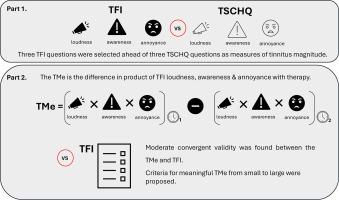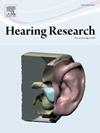耳鸣幅度方程(TMe)的探索性分析。一种基于适应水平理论的耳鸣治疗效果评价方法
IF 2.5
2区 医学
Q1 AUDIOLOGY & SPEECH-LANGUAGE PATHOLOGY
引用次数: 0
摘要
在这项研究中,我们对一种量化耳鸣感知强度变化的新方法进行了探索性分析:耳鸣幅度方程(TMe)。TMe是基于适应水平理论(ALT),是耳鸣功能指数(TFI)问题的乘积差,询问耳鸣响度,意识和烦恼(侵入性量表)治疗前后。方法对匿名数据进行二次分析。在第1部分。比较两组3个问题(n = 126)的内部一致性和内容效度。比较了耳鸣样本病例史问卷(TSCHQ)的三个问题和TFI的三个问题作为计算耳鸣适应水平(AL)和程度的候选措施。在第2部分。AL的变化,即治疗效果的大小,与TFI总分的变化进行比较(n = 155)。结果TSCHQ和TFI的两组问题大致相同,但TFI三项具有更高的内部一致性。TMe和TFI之间存在中等收敛效度。响应性的临时标准是相对于锚定和基于分布的测量方法确定的,这些测量方法表征了从小变化或更大变化(41%的参与者)到非常大变化(15%的参与者)的幅度。结论TMe是一种评估耳鸣的新方法,可以满足对耳鸣感知的可靠测量的需求。需要对该措施进行进一步的评估和验证。本文章由计算机程序翻译,如有差异,请以英文原文为准。

An exploratory analysis of the tinnitus magnitude equation (TMe). An adaptation level theory based measure of tinnitus therapy outcome
Background
In this study we undertook an exploratory analysis of a new method for quantifying change in perceived intensity of tinnitus: the tinnitus magnitude equation (TMe). The TMe is based on Adaptation Level Theory (ALT) and is the difference between the product of Tinnitus Function Index (TFI) questions asking tinnitus loudness, awareness, and annoyance (intrusiveness scale) before and after therapy.
Methods
This is a secondary analysis of anonymized data. In part 1. Two sets of 3 questions (n = 126) were compared for internal consistency and content validity. A triplet of questions from the Tinnitus Sample Case History Questionnaire (TSCHQ) and a triplet from the TFI that were candidate measures for calculating the adaptation level (AL) to tinnitus and magnitude were compared. In part 2. Change in AL, the magnitude of treatment effect, was compared to the change in TFI total score (n = 155).
Results
The 2 sets of questions from the TSCHQ and TFI were broadly equivalent, but the TFI triplet items had higher internal consistency. Moderate convergent validity was found between the TMe and TFI. Interim criteria for responsiveness were determined relative to anchor and distribution-based measures that characterize magnitude from a small change or greater (41% of participants) to a very large change (15% of participants).
Conclusion
The TMe is a novel approach to the assessment of tinnitus that could address the need for a robust measure of tinnitus perception. Further evaluation and validation of the measure is needed.
求助全文
通过发布文献求助,成功后即可免费获取论文全文。
去求助
来源期刊

Hearing Research
医学-耳鼻喉科学
CiteScore
5.30
自引率
14.30%
发文量
163
审稿时长
75 days
期刊介绍:
The aim of the journal is to provide a forum for papers concerned with basic peripheral and central auditory mechanisms. Emphasis is on experimental and clinical studies, but theoretical and methodological papers will also be considered. The journal publishes original research papers, review and mini- review articles, rapid communications, method/protocol and perspective articles.
Papers submitted should deal with auditory anatomy, physiology, psychophysics, imaging, modeling and behavioural studies in animals and humans, as well as hearing aids and cochlear implants. Papers dealing with the vestibular system are also considered for publication. Papers on comparative aspects of hearing and on effects of drugs and environmental contaminants on hearing function will also be considered. Clinical papers will be accepted when they contribute to the understanding of normal and pathological hearing functions.
 求助内容:
求助内容: 应助结果提醒方式:
应助结果提醒方式:


